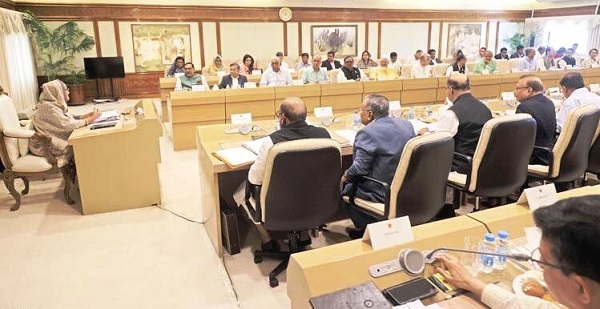Origins of the communal divide

Ali Ahmed Ziauddin:
POWER that be deny it exists, extremists on both sides justify it, moderates lament it, yet, this festering social disease goes on spewing blood and hatred, not confined to the subcontinent alone. In recent times, it seems to be spilling over wherever both communities share space. How do we explain such a bloody, disheartening, and often destructive phenomenon perpetrated in the name of religion? There is no easy answer. But accepting such a dreadful phenomenon as normal is not only morally repugnant; it’s also giving in to savagery. Instead, it’s pertinent to honestly ask why such horror exists at all; its roots and evolution in India in various forms need attention.
This instantly opens Pandora’s Box. Indian historiography is split over the origins of the divide. One school blames the British for igniting a rift between the two groups to advance its colonial interests. Another blames the Muslim invasion for creating hostility. Once their shock and awe treatment receded, both communities settled to share space. However, a deep emotional scar remained, festering in the shadows for centuries only to burst open in the freedom movement. The third school claims the origin of the discord is rooted in the caste system. It triggers another burning issue, the Aryan theory. The first school offers a limited vision influenced by the orientalist outlook with a devious intent to divide and rule at its heart. It fails to look beyond. The problem with the second school is that while it rejects the Aryan invasion/migration theory, it cannot provide a rational answer to the origin of the caste system or, worse yet, its continued existence.
The third school needs to establish the Aryan theory because caste was born in its womb. In brief, it’s as follows: sometime in the early to middle of the 2nd millennium BCE, the blue-eyed, white-skinned nomadic people started migrating in groups from their original homeland in the Russian steps towards warmer climates in the south and southeast regions of Iran and India. They entered from the north-west in the Indus Valley. Conflict with the locals ensued, but in the end, the newcomers prevailed. Once settled, the Aryans were outnumbered by the original but bickering natives. In order to keep them divided and subdued, the Aryans devised a cunning but effective technique: the caste system. It worked fine until it was applied as a division of labour, but once it became hereditary, i.e., racist, higher caste primacy became the norm, meaning birth alone decided the caste category and all the perks, privileges, and deprivation linked with it.
The problem is that despite long-held anthropological findings and recently done DNA tests asserting this claim, the Hindutva School refuses to accept it without giving any scientific evidence. Unaware, this line of thinking may lead to denying human migration from Africa and/or from different regions to more suitable ones all through history, including India. So it’s futile to deny the Aryan invasion/migration theory. But how is communal discord related to caste antagonism? For answers, one needs to peep into the broad contours of Indian history. And it starts right in the ancient texts. From the Rig Vedas, considered the oldest Hindu scripture, to all the following ones, the primacy of the twice-born higher castes is stated, of course, in varying scales. And the locals are scorned as Fiends, Dasyu, Rakshasa, Nishada, and so on.
This clearly indicates there was an enduring friction between the newcomers and the earlier inhabitants, a common trend whether in ancient or modern times. The Aryans were horse riders and far more warlike than the locals, though the latter were far more numerous. So, even if the newcomers were superior in battle, it took them more than millennia from the original point of entry to subdue the entire subcontinent and its inhabitants. While their military campaign was in progress, they were also introducing the caste system into society. The entire population was divided into the following four main groups: Brahmins were at the top of the social ladder; they were to provide leadership and moral guidance. Next were the Kshatriyas, the warriors who were to provide security for the resisting locals. Third were the Vaisyas, i.e., farmers, traders, and other mid-ranking professionals. The fourth were the Shudras, the original inhabitants, who were allocated small pieces of land for farming but were required mostly to provide manual labour for all purposes to the higher castes; they were not considered part of the Aryan social structure.
Besides these four castes, there was another, the Mlechchhas, i.e., the forest dwellers, cobblers, and butchers, considered impure and untouchable. Slowly, the Shudras and their multiple offshoot castes also came to be labeled as such. The two higher castes formed the Aryan nobility, or the ruling elite. Their system of governance and absolute hold on political and social power is what came to be known as Brahminism, or the Brahminic establishment. Though the Vaisyas too were of Aryan descent, as they engaged in trade, they were given a lesser status. Obviously, Shudras and all other local inhabitants were marked as inferior to the above three castes.
Initially, this was considered a sustainable division of labour. The massive influx of Aryan migrants must have caused social upheavals. The newcomers seeking a share of the produce must have turned the existing productive relationship topsy-turvy, triggering social unrest. On the one hand, the locals had no choice but to accommodate within the new order of things, while on the other, the abundance of fertile land was lucrative for the pastoral newcomers to settle down as farmers. But they knew nothing about farming, and as time advanced, more and more land had to be reclaimed by clearing the forests. So the locals had to be engaged either as tenants, hired hands, or, in worse cases, as bonded labour. Of course, there was mistrust on both sides, but the necessity of getting the productive forces together compelled both to build a working relationship. So, even if the locals were considered friends, they were an economic necessity. Strict caste rules were not introduced until then, though intermarriage was prohibited.
How long did this fragile coexistence last? It is impossible to tell for sure, but by the time the epics were being composed, strict caste rules were already in practice. When was that? The scientific assessment would be sometime between 1000 and 500 BCE, but according to the Hindutva School, it would be much further back. What necessitated the transformation of the division of labour into a system of vertical social division based on birthright alone? Finding the correct reasons will be nearly impossible to trace, not only because of a lack of hard evidence but also because the historical and religious texts written subsequently were all compiled by people from the higher castes. Nevertheless, a combination of intuitive knowledge, circumstantial evidence, and deductive logic may be of little help. All civilisations, while growing into one, had to address the pertinent issue of ownership of means of production, mostly land in whatever form. How it influenced the evolution of that particular civilisation. India is no exception.
Once the Aryans permanently settled, land had to be redistributed and new lands reclaimed by forest clearing. Obviously, they got the lion’s share, while the locals were left with just enough to survive. Moreover, as the Brahmin/Kshatriya castes enjoyed a privileged role in the Aryan hierarchy, they got even a bigger share. This was perhaps not a big problem because there was sufficient land for both the newcomers and the original inhabitants. The key reason for the gradual rise of caste antagonism arose later; it was rooted in the inheritance law over property and title and all the privileges that came with it. So long as land was owned and used communally, life was shared with others within caste lines without much friction, but once the issue over the inheritance of the privileges enjoyed by the two higher castes arose, conflict of interest was unavoidable.
Yudhishthir, the righteous king in the Mahabharata, observed,’No one is born either a Brahmin or a Sudra; only by attaining knowledge, honesty, love, restraint, free of hatred, lust, and charity, one becomes a Brahmin even if born a Sudra, and a Brahmin, lacking these qualities is a Sudra even if born a Brahmin’ (Rajshekher Bosu, p 214–15). Such an enlightened view was preached but rarely practiced at the time of its creation. Moreover, such a moral high ground is anathema to people seeking undue privilege at any time, whether past or present, except a few sages or prophets. Putting aside such moral dictates, the fact is that caste division was present even in the first recorded Indian monarchy of King Bimbisara around the 6th century BCE. But mythical history says otherwise.
Once society departed from the moral rigors mentioned above, social ills such as higher caste privileges became hereditary, thus beginning the original sin. From then on, birth alone determined the fate, status, and station of one’s life from cradle to grave. Surely there must have been a lot of anger and tension, but the growing alliance of Brahmin and Kshatriya castes forcefully implemented a social order that ensured their continued hold over power and property. They emerged as the permanent ruling caste or class called the Brahminic establishment, demanding total subjugation of all other castes. They were the hegemons of ancient India. More the power of this alliance grew, the more rigid the caste divide became. They devised a cycle of elaborate rituals to instill fear; only they could call upon the gods. No resistance from the lower castes was tolerated; they had no choice but to accommodate within this lopsided social order. Its permanence was doubtful.
For centuries, they remained moribund in their miserable existence. With no visible route out of such misery, the bulk accepted it as an inescapable fate. Tagore viewed such a condition correctly: ‘Every individual of every caste has his function assigned to him, together with the obsession into which he has been hypnotised, that, since he is bound by some divine mandate, accepted by his first ancestor, it would be sinful for him to seek relief therefrom.’ No matter what, they were after all human beings and, as such, had to eke out a living, procreate, and find joy, faith, and happiness. The bulk submitted to this Brahminic supremacy or order of things, while a few rebelled and became outlaws. Such an absolute and racist doctrine was presented as providence or an unalterable fact of life. No one dared ask a question; the consequences were harsh, from being marked an outlaw even worse to being an outcast. Once Brahminism was firmly established, the upper castes enjoyed tranquility. It was kind of like today’s US global hegemony. Anyone who dares disobey its diktats risks being not only sanctioned but, even worse, invaded, while its tiny ruling elite amasses incredible wealth and power.
That stage of social evolution was called the Vedic Age. This age produced the epics and many of the core codes of conduct for the entire society. While the ruling elite had leisure to cultivate civilisational attributes, they treated the lower castes appallingly. Just as the leafy, sprawling top universities of the West hide the nasty imperial faces of respective governments, the serene ‘Topobons (open air schools) of the Vedic Age too hide the dirty face of the Brahminic establishment. It was governed by a system that was economically exploitative and socially racist. But human nature is such that after a certain period of endurance, it begets resistance. Any undue privilege taken for granted by dint of birth alone over generations’ will, at some point, lead to decadence beyond redemption. Long Brahminic abusive hegemony gave rise to resentment, fatalism, and tension just below the surface. A backlash had become unavoidable. Such is the universal law.
Rise of passive resistance
HOWEVER, unlike the violent slave rebellion in ancient Egypt or Rome, the lower caste rebellion in India was more of a passive resistance. The rigidity of the Brahmin-Kshatriya establishment grew so tense that alternative faiths, doctrines, and theories that offered solace and dignity to lower castes drew attention. They sought relief from the awful caste yoke forced on them by a racist policy under the guise of a divine mandate. This gave rise to a series of Shramanic sects that all rejected the caste practice. These included the Buddhists, the Jains, the Ajivikas, the Charvakas, and even the Nastikas, i.e., non-believers. According to the celebrated historian Romila Thapar, ‘they all grew as antithesis to Vedic Brahmanism. Their teachings were clearly different, as were their social customs and institutions. No matter how much we insist Buddhism and Jainism have always been a part of Hinduism, their mutual hostility was noticed by the great linguist Panini in the 3rd century BCE; he equaled the relation of Brahminic and Shramanic dharmas to that of snake and mongoose.’ Whatever the socio-political impact, the lower castes found an alternative allegiance.
Among all the other Shramanic sects, Buddhism by the 2nd century BCE emerged as a counter-current to Brahminic supremacy for the next several centuries. It attracted a great number of lower caste followers as well as people from the trading caste; though of Aryan descent, they were not spared the smear by the Brahminic establishment either. Slowly, Buddhism became the state religion of multiple regional kingdoms in India. One of the key factors in the growth of the new religion in these kingdoms was that it encouraged trade, unlike the Brahminic mandate. In the 2–3 centuries before and after Christ India had a booming trade surplus with the Roman Empire. This in turn enriched the Buddhist kingdoms, of course at the chagrin of the Brahminic establishment that gradually lost influence in society. Moreover during more or less the same timeframe new invaders from central Asia embraced Buddhism, thus strengthening it further. The higher castes were unhappy. They harboured resentment. Friction was unavoidable. But it did not manifest in a decisive flare up rather it played out over many centuries centered on two diverse world views. Brahmin-Buddhist competition ensued for centuries all across India.
A key problem with all religions is that without power, they have limited influence; with power, their scope to cause good or bad becomes limitless. Buddhism was no exception. Although its simple universal ideas, along with few rituals and casteless appeal, unlike Brahminism, had enticed the lower caste peasantry to its fold, it could not relieve them from feudal exploitation, the foundation of all the kingdoms. This key weakness gradually crept into every nook and cranny of society in various forms, not to mention the caste divide. This took a long time — say, centuries — but in the meantime, Buddhism spread across Asia via the merchant community while Buddha’s teaching got mired in a series of conflicting doctrines at home. Corruption and decadence are common characteristics of all feudal societies, regardless of faith. After many centuries of competition with Brahminism for the hearts and souls of the Indians, Buddhism lost much of its emancipating pull, eventually waned, and slowly caved in within the Brahminic fold in the face of systematic persecution.
Any new faith, philosophy, idea, or culture can function in the same time and space as the existing ones without competing for power. But if and when it does, it has to compete with the existing ones for survival. While contesting over a long period, they may begin to complement each other. Confucianism and Buddhism were at odds in China before both gained acceptance. Christianity competed with paganism for a few centuries before emerging victorious, but along the way, it acquired many cultural norms of the latter. A similar experience isn’t difficult to imagine in the Brahmin-Buddhist rivalry. Surely, friction was there. Panini isn’t the only early Indian scholar who noticed the toxic relationship. In the 3rd century CE, when Buddhism had lost much of its socio-political power, the celebrated Hindu poet Kalidasa had no qualms about demeaning Buddhist nuns in one of his famous plays, Malavikagnimitra (Kanai Lal, Rise and Decline of Buddhism in India, page 386).
Finally, the famous Hindu philosopher and reformer Samkaracarya wrote in the eighth century CE, ‘The Buddha was an enemy of the people and taught conflicting or confusing things,’ in Brahmasutra-Sankara-Bhashya (Kanai Lal). These observations cover more than a thousand years and indicate the rise and decline of Buddhism and its gradual withering away in India. When it finally lost all power, even in the regions, the Brahminic hierarchy reasserted itself with new vigour and vengeance.
It made the Buddha a deity but purged all Buddhist teaching and institutions. Over time, it made historic compromises by accommodating a few lower caste customs and practices, like integrating the goddess of fertility within the Brahminic doctrine and relaxing the rigid caste divide slightly. But its torment of the Buddhists is well noted, ranging from social exclusion to forcible reconversion to the desecration of some of the Buddhist monasteries to even physical harm. A few of the well-known Indian historians, like Niharanjan, Kosambi, or Romila, have all concurred. After many centuries, the Brahminic establishment was once again the unchallenged authority across India—not all at once but in phases in different regions of India between the end of the Mauryan and the end of the Pala Empires. Buddhism slowly faded away from India’s socio-political scene.
Rise of a new alternative
WHENEVER and wherever there is asymmetry, whether in the physical world or social, the laws of nature rush in to fill in the void or attempt for symmetry. Just as the laws of physics say every action has an equal and opposite reaction, every socio-political action too has a similar reaction, perhaps not so quickly as in physics but rather slowly and at times at a snail’s pace. In the wake of Buddhism fading in India and the rise of rival multiple monarchical regional states, Brahminism again emerged as the main socio-political and cultural current in phases during the above-stated period. There wasn’t much visible countercurrent except for a few streaks of the Bhakti movement, i.e., offshoots of Vaishnavism. Brahminism, though relaxed a bit after absorbing the Buddhist threat, nevertheless remained a tool of racist and feudal oppression for the lower castes. There was scope for a countercurrent to appear. Islam filled that void from the 11th to the 18th centuries via multiple Muslim dynasties in various regions, probably without even being aware of playing that role.
Ever since Asoka, India has been a patchwork of multiple regionally, culturally, linguistically, and religiously diverse large and small kingdoms. Yes, two large empires rose and fell, but both failed to bring the whole of India under its heel except very briefly in the Mogul period, which was more of an aberration than a rule. The British attained that distinction but ruled diverse regional feudal states differently. Friction between these states was a regular affair during this period — an opportune moment for new invaders to seek fortune in India. In the post-Mauryan period, a series of tribes and people, i.e., the Bactrians, Scythians, Kushanas, Parthians, and the Huns, again from central Asia, invaded India between the 2nd century BCE and the 4th century CE. Bar the forgotten trek of the Africans, most other migrants and invaders to India were also from central or west Asia, including the Aryans. After a gap of 6–7 centuries, another series of invasions took place between the 9th and 16th centuries CE from the same region, perhaps progenies of the earlier people, but there was a difference.
These newcomers, i.e., the Turks, Persians, Afghans, and Arabs in the interim, had converted to Islam, whereas all the earlier ones were pagans. This made a difference. No invasion is ever peaceful. After initial raids and rampages to the horror of the locals, the Muslims finally settled as migrants and, over the next several centuries, became rulers, traders, farmers, preachers, and so on. While the Aryans had created their own faith, philosophy, and culture, the others had no endowments of their own. As such, it was easy for them to slowly embrace the faith and culture of the locals; some caved into the Brahminic fold as a new sub-caste, while others adopted Buddhism. But Muslims were part of a mature civilisation with many attributes that they were unwilling to let go of.
Their refusal to cave in the Brahminic canopy as a new subcaste remained a bone of contention for the Brahminic hierarchy, which also proved assimilation difficult. As Tagore put it, ‘two major civilisations with diverse worldviews met but refused to mingle’. But as rulers and the ruled had to interact for political and economic reasons, conditions were created for limited friendship to grow between the two communities, and some intermarriage also took place among the elites. Nevertheless, a deep and emotional wound remained among the strict Brahminic order outside the officialdom. Yet, both currents flowed abreast for centuries as feudal structure continued.
In the early period of Muslim invasion, forcible conversion must have taken place, but once they settled as permanent residents, that trend slowly ebbed away to make way for sharing the huge subcontinent as another new settled population. Surely the early raids and spree of temple and monastery destruction must have horrified the local populace, but once the Muslims settled as rulers, their power attracted many disgruntled groups, like the remnants of the Buddhists and some of the other Shramanic sects, to seek shelter from the Brahminic establishment. Many of them slowly, along with many others from the subaltern castes, converted to Islam. This increased the number of Muslims, along with many from the higher castes who were beneficiaries of the new power matrix. Moreover, the agency of the Muslim Sufis also played a role. Besides, many centuries of Muslim rule with a substantial populace spread all over India made them legitimate citizens.
Yet, all was not quite well. Just beneath the surface of the orderly monarchical administration, there was tension between the newcomers and the traditional social leadership belonging to the higher castes. Because the Muslims were unwilling to submit to the Brahminic hierarchy, the latter considered them ‘Mlechchhas’ meaning foreigners, invaders, or outcasts, i.e., polluted people, even after sharing the same neighbourhood for centuries. Muslims too became arrogant as conquerors and rulers; moreover, they weren’t free of caste disease either. In the Brahminic establishment, the Buddhists once were the hated other, but Muslims became a dreaded rival. While to the Muslim elites, the Hindus were ‘Kafirs’, i.e., infidels, a harsh term for all those who refused to convert to Islam. This became and has remained a disturbing and irritating issue ever since.
Moreover, besides the change of rulers belonging to a different faith and top-level administration, nothing much changed in the economic sphere; the feudal structure remained intact or, in some cases, was strengthened further to extract more taxes. Though both communities had opposing worldviews in the social realm, they nevertheless suffered feudal extortion, especially from the poor peasantry. They slowly began to interact among themselves in the cultural sphere. The Sufis and the Bhakti cults provided emotional refuge to both. Beyond the court and the elite circles, the Sufi and Sadhu shrines became the meeting points of the plebeians of both communities.
But the Muslim elites acted differently. Retaining their faith and heritage, they slowly developed a new cultural pattern known as Hindustani, a blend of both Hindu and Islamic elements. This, in essence, was Mughal court culture giving rise to a multicultural pattern well received in the elite circles across the subcontinent that still survives in various forms. Past the opulence of Muslim rulers and the privileged, life for the rest was one of struggle for both communities. Though not much friction was visible outwardly, a silent hostility could be traced among the Hindu elites just below the surface until Muslim rule crumbled. The British noticed it early on and abused it.
Brahminic resurgence
HOWEVER, during the freedom movement, hostility came out in the open. Since the Muslims were no longer rulers, the elites of the Hindu community began to imagine the return of Brahminic supremacy, i.e., a modern version of the Vedic age. The mainstream nationalist school was clearly anti-British but also contained anti-Muslim sentiments. The long, dormant grumble against the Muslim invasion and the desecration of Hindu and Buddhist temples and monasteries were presented as wanton acts of brutality. Such depiction omitted the fact that in the pre-industrial age in India as well as in all monarchical states elsewhere, both Hindu and Buddhist monarchies acted similarly after defeating the neighbouring monarchs. There are many records of such acts in the works of Richard Davis, R Eaton, R Thapar, H Mukhia, and B Chandra (Communalism and the Writing of Indian History, page 14, 31, and Essays on Islam and Indian History). Besides, when Mahmud regularly ravaged North India, the South Indian Chola king was sacking the regions in Southeast Asia.
Cherry picking from history blamed only the Muslim rulers while evading similar acts by others. When such a frame of mind was building the theoretical foundation of the freedom movement, it wasn’t only against the British colonists but against the Muslim rulers as well. The wider Muslim populace was suspect too. Seeds of communal divide and the making of a majoritarian Hindu nation were embedded in it. (Partho Chatterjee, in Itihaser Uttaradhikar, page 131).
However, it will be unfair not to mention a strong current in the national movement to create a composite national identity that had to give in to the pressure of rank and file for a majoritarian identity. Congress failed to accommodate the legitimate concerns of Muslims. The Muslims, nearly 25 per cent of the population, retorted by creating the Muslim League and later claimed to be a nation as a reaction. Conflict was unavoidable; one thing led to the other, eventually leading to the partying of the ways. The British typically played one against the other. Ever since, this region has gotten stuck in a vicious communal quagmire. All three parties were equally responsible for the tragedy of partition, a constitutional recognition of the communal divide. Where does it end in a volatile region armed with nuclear weapons?
Ali Ahmed Ziauddin is a researcher and activist.























Leave a Reply